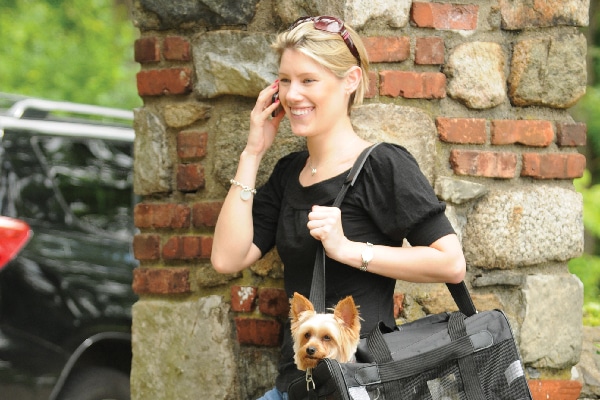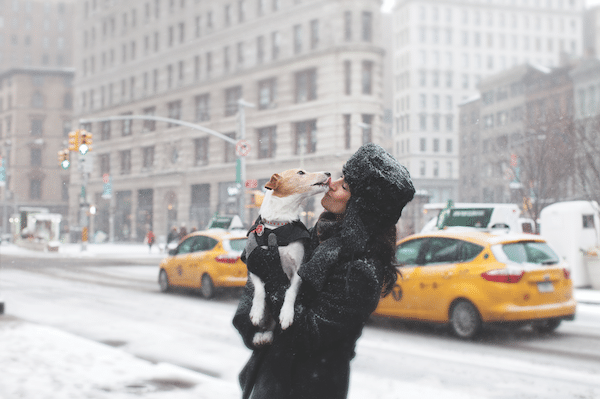Like many dog lovers, I read in horror as news broke about Kokito, a 10-month-old French Bulldog who died on a United Airlines flight from Houston to New York City last week. The puppy died after a flight attendant forced her owner to put the dog (who was in a carrier) into an overhead bin instead of under the seat. There is no air circulation in the overhead bins, and Kokito sadly passed away during the flight. United Airlines issued a statement saying that they “assume full responsibility for this tragedy and express our deepest condolences to the family and are committed to supporting them.” The airline added that it is “thoroughly investigating what occurred to prevent this from ever happening again.”
In fact, United Airlines had a bad week when it came to flying with dogs. The day after Kokito’s death, Irgo, a 10-year-old German Shepherd Dog who was moving from Oregon to Kansas with his family, was mistakenly put on a flight to Japan. Irgo is okay, and United flew him back to his family on a private jet, but it’s terrifying that the dog was lost in the first place and ended up in another country before anyone at the airline realized what had happened. Then, a few days later, a flight from Newark to St. Louis made an unscheduled landing in Ohio, because a dog was put onto the plane by mistake and was headed to a wrong destination.
So, what should dog parents know about flying with a dog? How can you keep your dog safe if you choose to or must fly with your dog? Let’s review some safety guidelines and what to know about flying with a dog.
Flying With a Dog — First, Why Do People Fly With Their Dogs?

Flying with a dog doesn’t have to be dangerous. Photography featuring SHERPA® Original Deluxe carrier, part of the Guaranteed On-Board® program. Photography courtesy sherpapet.com.
carrier, part of the Guaranteed On-Board® program. Photography courtesy sherpapet.com.
In our global world, pet owners increasingly want to travel with their pets — on land and in the air. In fact, 1 million animals are transported by airplanes every year. In some ways, flying with a dog is safe, and the Animal Welfare Act provides some guidelines intended to keep animals safe on airplanes, including how old they have to be, how long they can be left waiting before boarding, etc. Head to transportation.gov to learn more about the specific regulations for flying with a dog.
But, things can — and do — go wrong. So, is flying with a dog worth the risk? The Humane Society of the United States says no: “We strongly discourage having your pet travel by air in the cargo hold of a plane. It can be dangerous and stressful.”
But flying with a dog isn’t always dangerous. Some people do it regularly, for example, people who fly their large dogs in cargo to agility (and other dog sport and show) competitions domestically and internationally. People in the military also fly with their dogs when relocating to military bases around the world.
When my partner and I moved from Portland, Oregon, to New York, New York, 11 years ago we flew our (at the time only small) pets in the cabin of an airplane. There are lots of reasons that might necessitate flying with a dog, so here are some expert tips and suggestions for how and when it can be done safely.
Health Concerns About Flying With a Dog
If you’re looking at flying with a dog, there are some breed-specific concerns to keep in mind. “In summer months, many airlines won’t allow brachycephalic breeds to fly, those being French Bulldogs, Pugs and Bulldogs, because their anatomy can result in breathing complications, which are worse in summer months,” says Emmy-award winning veterinarian, Dr. Jeff Werber.
Additionally, it’s important to take the health of your dog into account. Dr. Werber advises that “any dogs with upper respiratory issues or any illnesses, should not fly.”
Your dog’s age should also be factored into the decision. “Older dogs might be restricted. For any age dog, make sure your dog is checked by a veterinarian to make sure she is healthy enough to fly,” says Dr. Werber.
When It Comes to Flying With a Dog, Every Single Dog Is Different
“Air travel is different for every dog, breed and owner,” cautions Gordie Spater, Cofounder and Chief Business Officer of Kurgo, which manufactures travel gear for dogs. “Knowing how to prepare for your next trip and what to look for in an airline will be key in having a safe and successful journey.”
When flying with a dog, you can’t ever be too prepared.
What to Do Before Flying With a Dog

Ensure you have the appropriate carrier before you travel with your dog. Photography featuring SHERPA® Original Deluxe carrier, part of the Guaranteed On-Board® program. Photography courtesy sherpapet.com.
carrier, part of the Guaranteed On-Board® program. Photography courtesy sherpapet.com.
1. Call Your Vet
Thinking of flying with a dog? Schedule a physical for your dog. “First, consult your vet before traveling,” Spater advises. “Not all dog breeds travel well or can handle the stress and air pressure changes when flying. Be sure to discuss how your pup will handle flying based on his or her breed, age and overall health.”
2. Research Pet-Friendly Airlines and Their Policies
Research airlines and find one with a track record for safely transporting dogs that you feel comfortable with. You can get a full overview of all incidents involving animals from the publicly released government reports.
3. Check Out Pet-Specific Flights
4. Purchase the Appropriate Under-Seat Carrier If Your Dog Is Traveling in the Cabin
Purchase an airline-approved, soft-sided carrier if you are flying with a dog in the cabin. Buy the carrier well ahead of time to ensure that your dog can fit inside the carrier and has time to get acclimated to it. Even dogs who are crate-trained may need some time to get used to a soft-sided carrier.
Check with your airline carrier about under-seat dimensions when booking your flight. Different airlines have slightly different specifications. Some airlines like Jet Blue sell their own carriers, which is an extra expense but one less thing to worry about the day of your trip since it ensures your carrier will be the right size.
5. Prepare Your Dog Properly If He’s Flying Cargo
If your dog is flying cargo, discuss all details of the trip ahead of time with your veterinarian and your airline to determine what medical records need to be provided, and if your dog is healthy enough to travel in cargo.
Purchase a crate that meets the requirements of the U.S. Department of Agriculture (USDA) and the International Air Transport Association (IATA) before the flight. This includes specifics about the size of the crate depending on the size of dog, what material the crate is made out of, etc.
Have food and water bowls attached to the front of the crate in such a way that food and water can be provided by airline staff without having to open the crate. Have dry dog food attached to the top of the crate. Secure all connection points on the crate, too.
Have your dog’s name, your name and your contact information clearly labeled on your dog’s crate prior to arriving at the airport. Dogs are not permitted to fly with toys in their crates.
6. Let the Airline Know That You Are Flying With a Dog
Once you’ve booked your flight, be sure to talk with your airline about exactly what will happen the day of your flight. If your dog is flying cargo, find out who will be interacting with your dog and how. “The cabin is safer, except in overhead bins, which can be lethal as a result of not enough oxygen, circulation, temperature control or panic,” Dr. Werber explains.
If you have a larger dog, he needs to fly in cargo. “The issues in cargo relate to temperature control, pressure control, oxygen and air circulation,” Dr. Werber cautions. “Although airlines always claim their cargo holds are well controlled, that is not always the case. If your dog is flying in cargo, it is recommended that you make sure that every airline representative you deal with is aware you will be flying with a pet in cargo. That includes the airline at the time you make the reservation, the check-in counter, the flight attendants and the pilot. Make sure they know your dog is there and to monitor temperature, pressure, oxygen and circulation. Don’t be shy.”
7. Make Sure Your Dog Has Appropriate Identification
“If you dog is flying with you in the cabin and will be with you at the airport the whole time, make sure he or she is properly tagged and has a collar with an ID,” Spater says. “Dogs are required to go through security at the airport, either in their owner’s arms or walking through the checkpoint on a leash. In this new and exciting environment, keep your dog close at all times. Not only will you be terrified if your dog is lost in the airport, your dog will definitely be frightened by the intimidating environment, too.”
More Tips for Flying With a Dog

Be an advocate and make sure all dogs arrive at their destinations safely. Photography by The Dog Photographer.
1. Advocate For Your Dog
If someone asks you to do something that feels dangerous or doesn’t seem right, don’t comply — your dog’s life could be at stake.
2. If You See Something, Say Something
If you see or hear someone being asked to do something that is dangerous or doesn’t seem right, be a good ally — stand up and support the dog parent. If even just one passenger had challenged the flight attendant’s request to move Kokito to an overhead bin, he might be alive today.
3. Legislate for Pet Traveling Rights
In response to the death of Kokito, his mom, dog lovers and New York State Senator Marison Alcantara (D-Manhattan) conducted a “dog-in” at the LaGuardia Airport with their dogs to protest Kokito’s death. They unveiled ‘Kokito’s Law,’ a canine passenger bill of rights to honor the memory of the puppy.
“Should it pass, Kokito’s Law would bar pets from being placed in overhead bins, ensure pet passengers have the same rights as human passengers, demand that cargo areas are pressurized, ventilated and climate controlled, and hold airlines to a number of other basic safety standards.”
Tell us: What do you think about flying with a dog? Have you ever flown with your dog? What tips would you add?
Thumbnail: Photography ©damedeeso | iStock / Getty Images Plus.
Looking for more travel tips? Check out these other articles about traveling with dogs:
- What You Need to Know for Traveling With Your Dog By Plane
- Q&A: How I Travel Internationally with a Large Dog
Sassafras Lowrey is an award-winning author. Her novels have been honored by organizations ranging from the Lambda Literary Foundation to the American Library Association. Sassafras is a Certified Trick Dog Instructor, and assists with dog agility classes. Sassafras lives and writes in Brooklyn with her partner, a senior Chihuahua mix, a rescued Shepherd mix and a Newfoundland puppy, along with two bossy cats and a semi-feral kitten. Learn more at sassafraslowrey.com
The post What to Know About Flying With a Dog — Safely appeared first on Dogster.
No comments:
Post a Comment